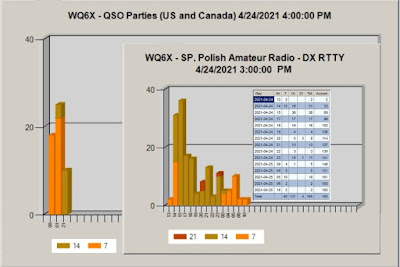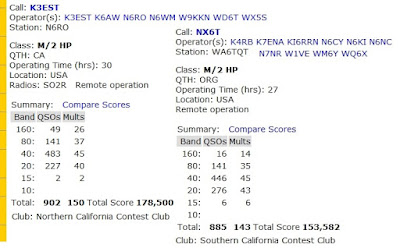This last weekend being another quiet one (radiosport-wise), the main interest was in the Brazilian-sponsored CQ MM contest. Only after-the-fact did I decide to revisit the 4 previous CQ MM GiGs
(ala Blast-from-the-Past Style).
- [VIEW] (2017) - CQMM Sets the Stage Weirdly for WQ6X
- [VIEW] (2018) - WQ6X survives contest weekend with Filtered-Frustration
- [VIEW] (2019) - WQ6X runs CQ-MM & 4 other Radiosport GiGs
- [VIEW] (2020) - CQMM Confounds and Confirms WQ6X @ NX6T
Altho CQMM was the main focus, there were a number of other events happening
during the weekend including:
- [X] WAPC (China)
- [X] YUDX Contest
- [X] MIQP - Michigan QSO Party
- [X] ONQP - Ontario QSO Party
Because I was mostly invested in the CQMM contest, it seemed too complicated to include the WAPC and YUDX GiGs in my operating schedule. Likewise for the MIQP and ONQP. The MIQP being a mere 12-hour event makes evening operation in that GiG all but impossible. While the ONQP at least gives us 24 hours, it would seem that more VE3/VA3 stations were working the CQMM event than their own QSO party - GO Figure.
Putting out a call for operators brought only WM6Y into the operation. Phil (PJ) and I swapped operating shifts throughout the 40 hours, while contending with the horrible Space-WX all weekend. Nevertheless, we managed a number of satisfying RUN periods, clearly at odds with the Space-WX predictions; remember, predictions are just that.
Aside from the CQMM operations, I used this weekend to test a newly swapped-in RRC-1258 at the Concord location, this unit sporting its own internet access capability; altho ironically, I was so busy operating, there was no time to test that capability - maybe next contest.
Being the [so-called] night-shift guy I was elected to start up the CQMM contest which began at 09:00z (2am), altho in all honesty I was not in "contest form" until 09:45z when I first checked the Russian military beacons; finding the usual "F" and "M" beacons and the "K" once again AWOL.
Replacing the K-Beacon was our recently acquired new "friend" the "motorboat Woodpecker".
Calling CQ on 7035.35 brought very little activity - I guess stations were later in getting started
than even *I* was. After searching and pouncing a bit, I parked the VFO on 7037.37 and pointed
the antenna to 120-degrees (South America). Because SA multipliers are important in this contest, first I let them come to me and then went on an S&P hunt for SA stations calling CQ MM.
My biggest frustration Saturday morning were the "juicy" (but weak) stations who would call-in just above the noise level and then give up after only 2 repeat requests.
Other CQMM stations kept moving
in on the run frequency necessitating
a move to 7013.13 (@10:50z), 7019.19 (@11:15z) and finally 7023.23 (@11:37z) where pointing the Shorty-40 yagi back to 300-Degrees (Asia) encountered Instant Indonesian Ssb-QRM.
At 12:05z refuge was taken on 7025.25
At 12:36z, after working all available CQMM stations on 40-meters a move was made to 3517.17 where I encountered Ssb-QRM moving in on me within minutes of NX6T's 80-meter arrival. Moving
to 3515.15 resulted in relief from that QRM, but resulted in only 1 QSO - where WAS Everybody?
Moving back to 7025.25 kept things alive until I took a break at 13:00z. After a coffee-IV, I came
back at 13:36 to S&P, finishing the morning on 7027.27 @14:00z. Phil (WM6Y) largely ran the day shift allowing me to do other things in the office before heading out to W7AYT where the RRC-1258 swap occurred.
WQ6X was back in the chair at 03:00z on 7012.12.
I immediately encountered a new approach to intentional-QRM - the high-speed CQ idiot. Every time a weak signal (mostly from South America) would call-in, this clown would call CQ (not CQ MM, just CQ) at 40+ WPM, obliterating the weaker station.
Eventually, stations stronger than him would call in, putting QSOs in the log. He would usually leave for a couple of minutes, allowing me to work the weak ones. After a lengthy S&P run, at 03:44z he was back at it.
He never DiD work anyone, so the QRM was clearly intentional.
I devised a special F-10 N1MM key for the next time he showed up and unfortunately never got a chance to use it. While I know the callsign of the offender, for legal reasons, I have chosen not to document it here.
At 04:40z a move was made to my favorite 80-meter Cw frequency: 3535.35. Later, when the QRM moved-in on me, I moved-in on 3515.15 where it was MUCH Quieter. Running out of energy I took
a sleep-break at 05:45z, coming back to 80-meters at 09:45z where I encountered several SA and Asian stations. Running 3515.15 brought even more, as well as e-coast stations (the 80-meter inverted VEE is hardly directional).
At 10:00z it was back to 40-meters to S&P and eventually settle in on 7012.12 once again, but w/o
the Cw Idiot; I guess it was past his bedtime; mommy and daddy wouldn't let him stay up that late. Unfortunately, he was replaced by the motor-boat Woodpecker now parked on 7015.15.
What I glean from these STATS is that the "day shift" had better band condx. available for QSO volume. Then again,
if I hadn't slept those 4 hours Saturday evening there might've been more 80/40 activity - the usual woulda/shoulda/coulda.
Nevertheless, when you consider what we had to work with, our numbers are reasonably respectable.
The BiG Secret to this GiG was largely to run frequencies, encouraging callers to come to us.
Breaking things down by band,
more or less confirms the above OP stats. 20 meters was clearly our top band, followed by 40, 15, 80 & 10 meters.
While I gave 160 a look from time to time, no replies were made to the CQ calls there. I guess when it comes to CQ MM, 160 meter operators are clueless - Amazing.
Considering the horrible Space-WX condx, our success on 10 & 15 meters as minimal as it was, is commendable.
While I ran QSOs much of Sunday afternoon, WM6Y came in for the final shift to put the last QSOs in the log, giving WQ6X the opportunity to make the scene from STN-1. I began things on 20 meters, while Phil, ran 10 and then 15 meters. Eventually we switched, with WQ6X on 15 and NX6T on 20. To end the contest, we swapped bands once again; altho in retrospect, I probably should have gone
down to 40.
Nevertheless, when it was all over, it would seem that our NX6T dual-OP operation took 5th-place overall, 3rd-place for USA/NA and 1st-place for the entire Left Coast, while WQ6X at least got to submit a log, upping my annual contest stats for 2021.
DiD YOU work the CQMM contest?
Is NX6T or WQ6X in YOUR LoG?




















